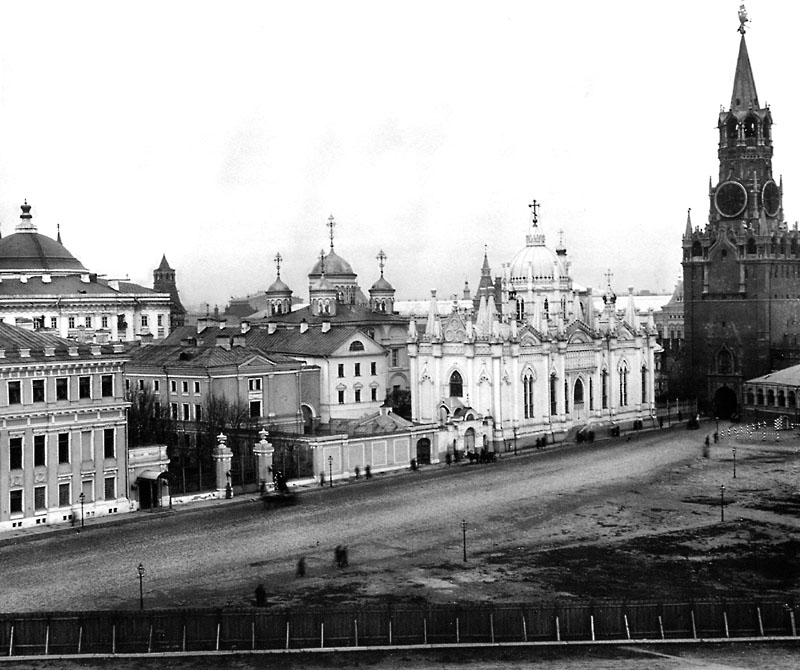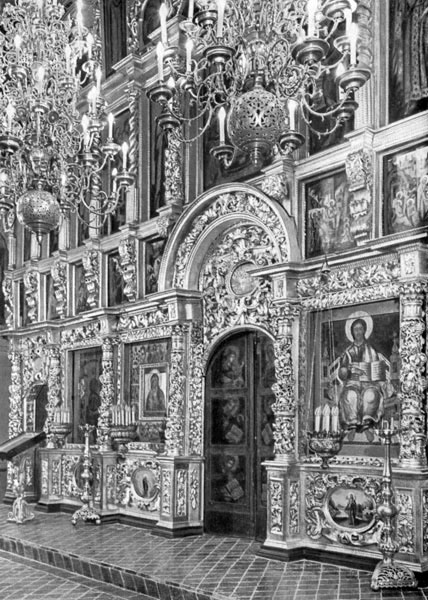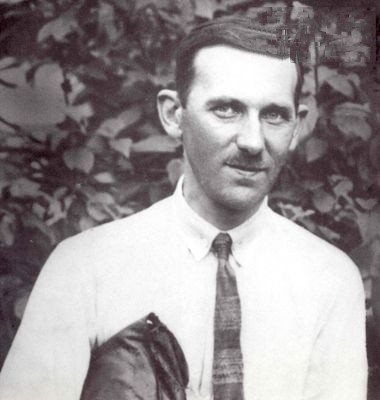by Susan Flantzer
© Unofficial Royalty 2022

Ascension Monastery in 1900; Ascension Cathedral, with four of the five towers showing, is in the middle of the photo; Credit – Wikipedia
The Ascension Convent was a Russian Orthodox nunnery in the Moscow Kremlin in Moscow, Russia. The Moscow Kremlin is a fortified complex founded by the Rurik dynasty in the late 15th century. It includes five palaces, four cathedrals, and the enclosing Kremlin Wall. Before the founding of St. Petersburg by Peter I (the Great), Emperor of All Russia in 1703, the Moscow Kremlin was the seat of power for the Rurik and early Romanov rulers of Russia. The Moscow Kremlin now serves as the official residence of the President of the Russian Federation.
Women of the Rurik dynasty and women of the early Romanov dynasty along with some Russian noblewomen were interred at the Ascension Cathedral of the Ascension Convent. When Peter I (the Great), Emperor of All Russia, moved the capital of Russia from Moscow to the new city of St. Petersburg, the new Peter and Paul Cathedral became the Romanov burial site.
In 1929, the Ascension Convent and its cathedral were destroyed by the Soviets to make room for the Red Army School. At that time, the remains of those buried there were moved to the crypt of the Archangel Cathedral in the Moscow Kremlin.
********************
History of the Church

The Ascension Cathedral in the 1800s; Credit – Wikipedia
Around 1386, the first wooden church of the nunnery was founded by Evdokia Dmitrievna of Suzdal, Grand Princess of Moscow, wife of Dmitry Donskoy, Grand Prince of Moscow. The church was dedicated to the Ascension of Jesus, the Christian teaching that Jesus physically departed from Earth by rising into Heaven. After the death of her husband, Evdokia Dmitrievna became a nun under the name Euphrosyne at the nunnery and was buried in the church upon her death. She was canonized by the Russian Orthodox Church and is known as St. Euphrosyne of Moscow.

Shrine of St. Euphrosyne of Moscow in the Archangel Cathedral in the Moscow Kremlin; Credit – By Иерей Максим Массалитин – originally posted to Flickr as Святая Евфросиния Московская, CC BY-SA 2.0, https://commons.wikimedia.org/w/index.php?curid=12193132
In 1415, the church was mostly destroyed by fire and was rebuilt in 1467 by Maria Yaroslavna of Borovsk, Grand Princess of Moscow, wife of Vasily II, Grand Prince of Moscow. Another fire in 1483 resulted in another restoration. From 1587 – 1588, the church was completely rebuilt as a cathedral with five domes, mirroring the Archangel Cathedral which had been built nearby in the Moscow Kremlin in 1508.

Ascension Cathedral in 1907; Credit – Wikipedia
********************
Destruction of the Convent and Cathedral

Nuns at the Ascension Convent in 1904; Credit – Wikipedia
In 1907, the nunnery had a mother superior, 62 nuns, and 45 lay sisters. Ten years later, during the Russian Revolution, the nunnery and its buildings suffered much damage and the nuns were ordered to leave. In 1918, the Kremlin Commission was established to restore and preserve the Kremlin buildings. However, due to insufficient funding, the plans were not fully implemented and work stopped in 1920. In 1924, the ground on which the Ascension Convent sat began to sink and some walls of the buildings started to collapse.

The iconostasis, the wall of icons and religious paintings separating the nave from the sanctuary in an Orthodox church, of the Ascension Cathedral which was saved and is now in the Church of the Twelve Apostles; Credit – Wikipedia
In 1929, it was announced that plans were being prepared for the construction of the Red Army School on the land occupied by the Ascension Cathedral and other historical buildings. A plea was made to change the location to preserve the historical buildings but it was ignored. In December 1929, on the orders of Joseph Stalin, the dismantling and demolition work began. The work was done in a hurry and archaeologists were not allowed to remove valuable frescoes in the churches and only a few church decorations were saved.

Removing the sarcophagi before the destruction of the Ascension Monastery; Credit – Wikipedia
Thanks to Nikolai Nikolaevich Pomerantsev, an art restorer and art curator, the sarcophagi in the Ascension Cathedral were saved. Pomerantsev organized architectural measurements and photographing of the monastery, a survey of the burials, and the removal of the sarcophagi to the crypt in the Archangel Cathedral. In January 1934, Pomerantsev was arrested and accused of trying to discredit the Soviet government by opposing the demolition of unnecessary monuments of antiquity. In May 1934, he was sentenced to three years of exile.

Nikolai Nikolaevich Pomerantsev, who is responsible for saving the sarcophagi at the Ascension Cathedral; Credit – Wikipedia
********************
Burials

Tsarevna Praskovia Ivanovna of Russia, daughter of Ivan V, Tsar of All Russia, was the last person interred at Ascension Cathedral; Credit – Wikipedia
Listed below are relatives of Grand Princes of Moscow, Tsars of Russia, and Emperors of Russia who were interred at the Ascension Convent and were moved in 1929 to the Archangel Cathedral in the Moscow Kremlin. Relatives of Russian nobles were also buried there but are not included in the list below.
- Grand Prince (Великий князь Velikiy Knyaz: literally great prince, sometimes translated as grand duke) was the title of the male ruler of the Russian principalities before they were united into the Tsardom of Russia. A Grand Prince’s wife was titled a Grand Princess.
- Tsar was used 1547 – 1721 to denote the male ruler of Russia. Tsar comes from Caesar, the Latin title of a Roman emperor. Tsar remained the popular designation of the Russian ruler despite the official change of style to Emperor in 1721.
- Tsaritsa or Tsarina was the title of the female ruler of Russia or the title of a Tsar’s wife. It was officially used from 1547 – 1721 when the title changed to Empress although Tsaritsa or Tsarina was sometimes still used.
- Tsarevich was the title given to Tsars’ sons before the 18th century.
- Tsarevna was used before the 18th century as the title for the daughter of a Tsar or the wife of a Tsarevich.
Patronymic: In Russian, a patronymic is the second name derived from the father’s first name: the suffix -vich means “son of” and the suffixes -eva, -evna, -ova, and -ovna mean “daughter of”.
- Evdokia Dmitrievna of Suzdal, Grand Princess of Moscow (1353 – 1407), wife of Dmitry Donskoy, Grand Prince of Moscow
- Sophia of Lithuania, Grand Princess of Moscow (1371 – 1453), wife of Vasily I Dmitriyevich, Grand Prince of Moscow
- Maria Borisovna of Tver, Grand Princess of Moscow (1442 – 1467), first wife of Ivan III, Grand Prince of Moscow
- Maria Yaroslavna of Borovsk, Grand Princess of Moscow (1418 – 1484) wife of Vasily II, Grand Prince of Moscow
- Sophia Palaiologos, Grand Princess of Moscow (circa 1449 – 1503), wife of Ivan III, Grand Prince of Moscow
- Elena Stefanovna of Moldavia, Crown Princess of Moscow (1465 – 1505) wife of the son of Ivan the Young, Crown Prince of Moscow
- Princess Eudoxia Ivanovna of Moscow (1492 – 1513), daughter of Ivan III, Grand Prince of Moscow, wife of Peter (born Kudaikul) of Kazan
- Elena Vasilievna Glinskaya, Grand Princess of Moscow (circa 1510 – 1538) , second wife of Vasily II, Grand Prince of Moscow
- Princess Anastasia Petrovna of Moscow (died 1541), niece of Vasily III, Grand Prince of Moscow,
- Tsarevna Maria Ivanovna (1551 – 1552), daughter of Ivan IV (the Terrible), Tsar of Russia
- Tsarevna Evdokia Ivanovna (1556 – 1558), daughter of Ivan IV (the Terrible), Tsar of Russia, among the nameless sarcophagi
- Anastasia Romanovna, Tsaritsa of Russia (1530 – 1560), first wife of Ivan IV (the Terrible), Tsar of Russia, great-aunt of Michael I of Russia, the first Tsar of the Romanov dynasty
- Maria Temryukovna, Tsaritsa of Russia (circa 1544 – 1569), second wife of Ivan IV (the Terrible), Tsar of Russia
- Marfa Vasilievna Sobakina, Tsaritsa of Russia (1552 – 1571) third wife of Ivan IV (the Terrible), Tsar of Russia
- Tsarevna Feodosia Feodorovna of Russia (1592 – 1594), daughter of Feodor I, Tsar of Russia
- Irina Fyodorovna Godunova, Tsaritsa of Russia (1557–1603) wife of Feodor I, Tsar of Russia, sister of Boris Godunov, Tsar of Russia
- Maria Fedorovna Nagaya, Tsaritsa of Russia (died 1608), eighth wife of Ivan IV (the Terrible), Tsar of Russia
- Tsarevna Anna Vasilievna of Russia (born and died 1609), daughter of Tsar Vasily IV, Tsar of Russia
- Praskovia Mikhailovna Solovaya, Tsarevna of Russia (died 1621), second wife of Tsarevich Ivan Ivanovich of Russia
- Maria Vladimirovna Dolgorukova, Tsaritsa of Russia (1601 – 1625), first wife of Michael I, Tsar of All Russia, the first reigning member of the Romanov dynasty
- Ekaterina Petrovna, Tsaritsa of Russia ( born Maria Buynosova-Rostovskaya) (died 1626), second wife of Vasily IV, Tsar of Russia
- Tsarevna Pelageya Mikhailovna of Russia (1628 – 1629), daughter of Michael I, Tsar of All Russia
- Tsarevna Marfa Mikhailovna of Russia (1631 – 1631), daughter of Michael I, Tsar of All Russia
- Tsarevna Sofya Mikhailovna of Russia (1634 – 1636), daughter of Michael I, Tsar of All Russia
- Tsarevna Evdokia Mikhailovna (born and died 1637), daughter of Michael I, Tsar of All Russia
- Eudoxia Lukyanovna Streshneva, Tsaritsa of Russia (1608 – 1645), second wife of Michael I, Tsar of All Russia
- Tsarevna Anna Alekseevna of Russia (1655 – 1659), daughter of Alexei I, Tsar of All Russia
- Tsarevna Evdokia Alekeevna (born and died 1669), daughter of Alexei I, Tsar of All Russia
- Maria Ilyinichna Miloslavskaya, Tsaritsa of All Russia (1624 – 1669), second wife of Alexei I, Tsar of All Russia
- Tsarevna Feodora Alekseevna of Russia (1674 – 1677), daughter of Alexei I, Tsar of All Russia
- Agaphia Semenovna Grushevskaya, Tsaritsa of All Russia (1663 – 1681), first wife of Feodor III, Tsar of All Russia,
- Tsarevna Feodosia Ivanovna of Russia (1690 – 1691), daughter of Ivan V, Tsar of All Russia
- Tsarevna Anna Mikhailovna of Russia (1630 – 1692), daughter of Michael I, Tsar of All Russia
- Tsarevna Maria Ivanovna of Russia (1689 – 1692), daughter of Ivan V, Tsar of All Russia
- Natalya Kirillovna Naryshkina, Tsaritsa of All Russia (1651 – 1694), second wife of Alexei I, Tsar of All Russia and the mother of Peter I (the Great), Emperor of All Russia
- Tsarevna Tatyana Mikhailovna of Russia (1636 – 1706), daughter of Michael I, Tsar of All Russia
- Grand Duchess Natalia Alexeievna of Russia (1714 – 1728), daughter of Alexei Petrovich, Tsarevich of Russia and granddaughter of Peter I (the Great), Emperor of All Russia
- Tsarevna Praskovia Ivanovna of Russia (1694 – 1731), daughter of Ivan V, Tsar of All Russia, wife of Ivan Ilich Dmitriev-Mamonov
This article is the intellectual property of Unofficial Royalty and is NOT TO BE COPIED, EDITED, OR POSTED IN ANY FORM ON ANOTHER WEBSITE under any circumstances. It is permissible to use a link that directs to Unofficial Royalty.
Works Cited
- En.wikipedia.org. 2022. Ascension Convent – Wikipedia. [online] Available at: <https://en.wikipedia.org/wiki/Ascension_Convent> [Accessed 21 March 2022].
- Ru.wikipedia.org. 2022. Вознесенский монастырь (Москва) — Википедия. [online] Available at: <https://ru.wikipedia.org/wiki/%D0%92%D0%BE%D0%B7%D0%BD%D0%B5%D1%81%D0%B5%D0%BD%D1%81%D0%BA%D0%B8%D0%B9_%D0%BC%D0%BE%D0%BD%D0%B0%D1%81%D1%82%D1%8B%D1%80%D1%8C_(%D0%9C%D0%BE%D1%81%D0%BA%D0%B2%D0%B0)> [Accessed 21 March 2022].
- Ru.wikipedia.org. 2022. Некрополь Вознесенского монастыря — Википедия. [online] Available at: <https://ru.wikipedia.org/wiki/%D0%9D%D0%B5%D0%BA%D1%80%D0%BE%D0%BF%D0%BE%D0%BB%D1%8C_%D0%92%D0%BE%D0%B7%D0%BD%D0%B5%D1%81%D0%B5%D0%BD%D1%81%D0%BA%D0%BE%D0%B3%D0%BE_%D0%BC%D0%BE%D0%BD%D0%B0%D1%81%D1%82%D1%8B%D1%80%D1%8F> [Accessed 21 March 2022].
